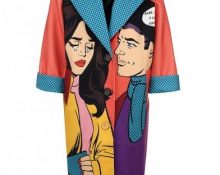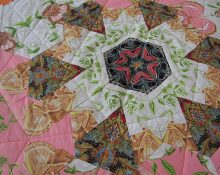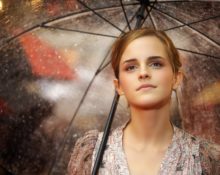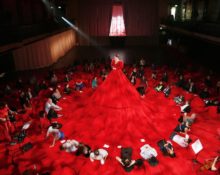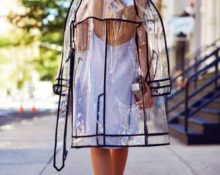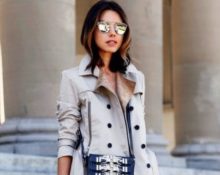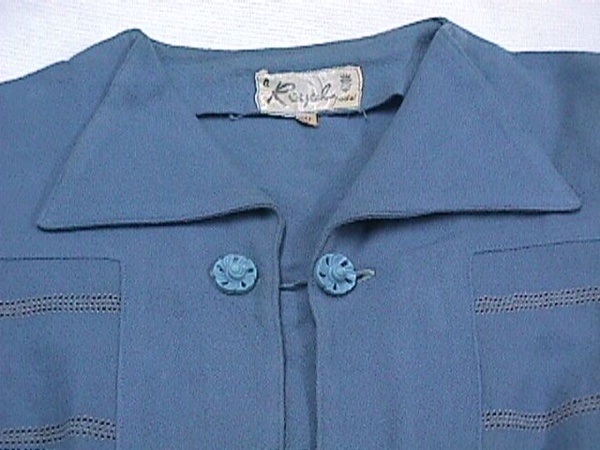
creativecommons.org
A raincoat, or trench coat, is considered a universal outerwear for autumn and spring. To liven up the look, fashionistas often use colored raincoats. A blue raincoat is one of the trends for 2021-2022. In this material we will tell the history of the evolution of the raincoat, and also show examples of what you can wear with a blue raincoat. At the end of the article you will find recommendations on what you will need to sew a blue raincoat with your own hands.
A brief history of the cloak: from modern times to the present day
The cloak is probably the most ancient item of clothing. Ancient people wore animal skins to protect themselves from rain and cold. Later, the ancient Greeks replaced animal skins with fabrics to cover togas. With the development of dyeing, cloaks acquired an additional function: demonstrating the status of their owner, for example, red cloaks were worn by the commanders-in-chief of the Roman army, and white cloaks were worn by high-ranking officials.Over time, raincoats spread throughout Europe; each country (and sometimes each individual region) had its own forms of raincoats (semicircular, rectangular, trapezoidal) and ways to fasten them. Most often, cloaks were made of wool and dyed in dark shades of brown, red, blue and green. Pastel shades, like blue, were used extremely rarely in the manufacture of raincoats and, if they were sewn, they were exclusively intended for carnivals.
At the very beginning of the Middle Ages, only wealthy people could afford cloaks. Behind the wide flaps of the cloak, noble people and church representatives could not only keep warm on a cool evening, but also hide their faces from prying eyes. The popularity of cloaks waned by the beginning of the 14th century, when this clothing became associated with the poor and petty robbers. However, in the middle of the 16th century, the cloak again came into fashion among the Spanish grandees and all classes began to wear it: the nobility ordered long, heavy cloaks with rich embroidery and contrasting lining; The townspeople imitating the nobles also kept up with their role models and were content with more budget-friendly materials, and the military and mercenaries wore fashionable cloaks to make it more convenient to hide weapons behind wide draperies of fabric. Military men especially loved cloaks: by the middle of the 15th century, musketeers, the royal guard, began to be associated exclusively with blue cloaks, which became their uniform uniform. The fashion for cloaks disappeared only with the advent of the French Revolution, whose bloody supporters not only changed the legislation and calendar, but also banned all residents of the country from wearing noble clothes.
The next starting point is 1823, when the Scottish chemist Charles Mackintosh invented a waterproof raincoat, which received his name.Before this, woolen raincoats, despite the lining, got wet, although they retained warmth. And Mackintosh placed a layer of rubber between the outer part of the raincoat and the lining. Thirty years later, an enterprising London tailor, John Emary, founded a brand of raincoats under the Aquascutum brand. And already at the end of the 19th century, Thomas Burberry invented a fabric with water-repellent properties, gabardine, and raincoats began to be made from new raw materials, although they retained their old name, mackintoshes, or poppies for short. During the First World War, the raincoat acquired another name - the trench coat, or trench coat. The name comes from the English word “trench” - trench. This is what British soldiers called their military capes, which they wore in trenches and trenches. During the next war, trench coats were also popular. Civilians also wore trench coats to demonstrate their patriotism. Naturally, in those days, macs and trench coats were of the most practical shades and designers were in no hurry to sew blue raincoats.
All of the above versions of raincoats are similar in essence, but differ slightly in cut.
So there are the following subtypes of raincoats:
- English classic raincoat. Most often single breasted.
- A cloak-cape, whose shape was borrowed from the inhabitants of the Middle Ages.
- A raincoat, or mackintosh, made from a special water-repellent fabric.
- A trench coat, or trench coat, is a double-breasted raincoat model equipped with a belt with a buckle. This form is known to many from detective stories of the 1970s.
- A cloak-robe is a cloak based on the cut of a wraparound robe.
- A raincoat-tent is a mandatory attribute for tourists.
- Anther is a summer raincoat that is thrown on during trips instead of a cardigan or poncho.
- Hubertus is an insulated raincoat with a high collar.Initially it was part of the men's wardrobe, but over the past ten years it has gradually begun to move into the women's half.
- A cape is a loose-fitting cape that resembles a poncho. Sometimes without sleeves, sometimes just with slits instead. This shape looks very feminine and is often available in pastel colors, including blue.
In addition to all of the above, there are such hybrid forms as a raincoat-jacket and a raincoat-coat.
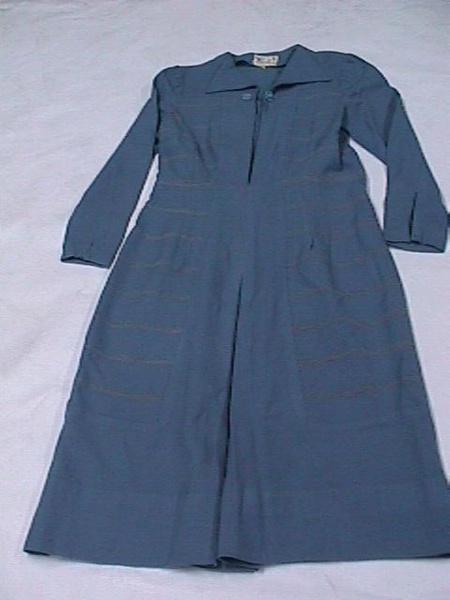
creativecommons.org
What to wear with a blue raincoat
Today, democratic fashion allows you not only to wear a blue raincoat, but also to combine it with almost all styles. So, just a few years ago it was difficult to imagine a girl in a blue raincoat of a classic cut and sports sneakers. But today models in such non-standard images not only appear on the catwalk, but also wear such combinations in everyday life. A blue trench coat doesn't have to be paired with white palazzo pants from the 1970s. A sky-colored trench coat will work well in a standard 1990s look when paired with blue jeans and a crop top. A blue raincoat can also be worn with leggings and even a baseball cap. Today, stylists boldly play with different trends, combining the incongruous. But if you are a supporter of the classics, then a win-win combination would be a blue raincoat, complemented by a white pleated skirt or a light dress with pumps. In principle, with such a raincoat, white and gray wardrobe items look most common. But if you want to experiment, you can try adding cropped pants in medium or small check to the blue raincoat. As for accessories, you can add another trendy item to your look - a small leather bag on a chain.For contrast, you can match the blue raincoat with dusty pink clothing items. A bright accent to a monochrome blue look with a red bag and boots or shoes of the same shade will unexpectedly look good.
What you need to sew a blue raincoat
In this article for beginners, we will look at the simplest cut of a raincoat - a cape. If you wish, you can even sew a blue cape without using a pattern. But if you have little experience in working with outerwear, then it is better to use the diagram provided in this article.
For sewing you will need:
- A piece of water-repellent fabric for sewing a blue raincoat.
- Sewing supplies.
- Pattern adjusted to the parameters of the model.
- Buttons. For a blue raincoat, it is better to choose contrasting shades of fittings.
Step-by-step plan for sewing a blue cape
If you are a beginner seamstress and the cape does not suit you, we do not recommend starting with a trench coat right away, since sewing it requires working with the lining. It is best to sew such things in a studio or under the guidance of an experienced craftsman.
- Secure the completed patterns to the required parameters onto the fabric folded in half using pins. It is better to add a little width on the sides of the product so that there is a loose fit (on average 8-10 cm + 1.5 cm for indentations on each side). You should have the following parts: a back, two shelves, two hems, two sleeves and a collar.
- Baste the product and try it on the model.
- Adjust if necessary.
- Sew all parts of the blue cloak, finishing all the folds and edges.
- Sew on the buttons.


 0
0